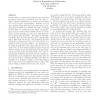Free Online Productivity Tools
i2Speak
i2Symbol
i2OCR
iTex2Img
iWeb2Print
iWeb2Shot
i2Type
iPdf2Split
iPdf2Merge
i2Bopomofo
i2Arabic
i2Style
i2Image
i2PDF
iLatex2Rtf
Sci2ools
SDM
2007
SIAM
2007
SIAM
Maximizing the Area under the ROC Curve with Decision Lists and Rule Sets
Decision lists (or ordered rule sets) have two attractive properties compared to unordered rule sets: they require a simpler classification procedure and they allow for a more compact representation. However, it is an open question what effect these properties have on the area under the ROC curve (AUC). Two ways of forming decision lists are considered in this study: by generating a sequence of rules, with a default rule for one of the classes, and by imposing an order upon rules that have been generated for all classes. An empirical investigation shows that the latter method gives a significantly higher AUC than the former, demonstrating that the compactness obtained by using one of the classes as a default is indeed associated with a cost. Furthermore, by using all applicable rules rather than the first in an ordered set, an even further significant improvement in AUC is obtained, demonstrating that the simple classification procedure is also associated with a cost. The observ...
| Added | 30 Oct 2010 |
| Updated | 30 Oct 2010 |
| Type | Conference |
| Year | 2007 |
| Where | SDM |
| Authors | Henrik Boström |
Comments (0)

